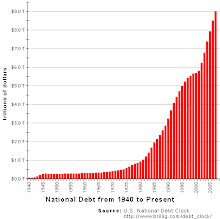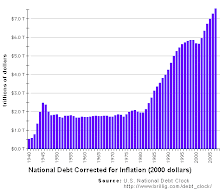
Advocates of U.S. Presidential candidate Ron Paul, seem befuddled that his economic proposals do not receive more support and consideration. I am unsure if their criticisms of the U.S. Federal Reserve System (the Fed) are objections to the existence of paper money, central banks, or to the specific operation of the Fed. Monetary policy for an increasingly interconnected world is complex. It is reasonable that most people do not understand it. But it can be understood. Let me try to address a few issues.
Money is anything that is generally accepted to serve as a medium of exchange (i.e., you can buy things with it), a store of value (i.e., you use it to save purchasing power for use at a later time), and a unit of account (i.e., it is used to measure relative prices). Stated more simply, money facilitates commerce. Without money that is widely accepted, easy to carry and exchange, and difficult to counterfeit, economic transactions become much more difficult. Without money, people must rely on barter for exchanges of goods and services. For example, a yoga teacher would trade yoga instruction for everything she wants to buy. Paper money, such as Federal Reserve Notes, has been used since the 7th century because it conveniently serves the functions of money. Although it has no intrinsic value, paper money has historically been one of the most widely used forms of money. Bank deposits, such as those created under the fractional reserve banking systems that are common throughout the developed world, are another form of money of similar importance in modern times.
The reason why politicians other than Ron Paul are not advocating the elimination of the Federal Reserve System is because there is a broad consensus among politicians, economists, and the leaders of finance and business that central banks, such as the Fed, provide a necessary function for a developed society. Prior to the creation of the Federal Reserve System in 1913, the U.S. monetary and banking systems were chaotic and their instabilities impeded commerce and economic growth. Because central banks oversee the money supply and banking system, every country with its own currency needs a central bank. They all function essentially in the same way as the Fed.
The primary benefit of a central bank, such as the U.S. Federal Reserve System, is that it promotes a healthy and stable banking system capable of supporting economic growth. It also ensures that society has an appropriate quantity of reliable money to facilitate commerce.
The simplest refutation of the desirability of returning the U.S. to a gold standard is that the money supply would not typically increase unless the U.S. acquired more gold. A benefit of this is that it would prevent excessive inflation. But it would almost certainly lead to devastating deflation and it would make it nearly impossible for the U.S. to use monetary policy to reduce the duration and severity of economic downturns, such as the recent global recession.
Here is a simple example. As a country’s population increases and its economy grows, it needs a larger money supply. If there are a million people earning $1 per day, the economy needs $1 million per day to pay these workers. If the population doubles to 2 million, but the money supply has not increased because the country has not acquired more gold, then the existing $1 million must be sufficient to pay 2 million people. So people earn fifty cents per day instead of a dollar. With these lower labor costs, prices of goods and services fall, too. An overall reduction in the price level, which economists call deflation, might seem desirable. But it is devastating to an economy. It causes a dramatic reduction in purchases of newly produced goods and services. (Why buy something today if you know it will be cheaper next week, next month, or next year?) Deflation increases unemployment as businesses lay off workers because there is reduced demand for their products as consumers postpone purchases until the future (when they will be cheaper).
Developed modern economies have a money supply that is primarily composed of currency and bank deposits and is overseen by a central bank. This allows the money supply to be adjusted to the changing needs of society. The money supply can be easily altered to accommodate changes in population and economic growth. And because central banks influence the amount of money created by private commercial banks in the form of loans, monetary policy is a primary instrument of macroeconomic policy. In prosperous times, central banks fight inflation by encouraging banks to lend less money to the public and thereby reducing overall spending on newly produced goods and services. When the economy is sluggish, central banks promote economic growth and reduce unemployment by encouraging banks to lend more money and thus increase the demand for newly produced goods and services. (As sales increase, businesses rehire workers they laid off or hire new ones.) Mainstream society wants governments to take action to promote economic prosperity and reduce the negative impacts of macroeconomic declines. (See "The Economic Role of Government" for elaboration.)
Ron Paul seems to have considerable fears about hyperinflation. A few economies (with currencies not backed by gold and a central bank similar to the Fed) have suffered hyperinflation. But this does not imply that such a fate in inevitable. An examination of the U.S. inflation rates since 1956 provides no evidence that Fed policies have caused excessive increases in the price level.
Ron Paul’s opinions of the Fed are viewed by mainstream society the same way it views people who claim the earth is flat, that the sun orbits the earth, that man never went to the moon, that the best way to cure all illness is to drain blood from the body, that there is no such thing as evolution, that the earth is only 6,000 years old, or that President Barack Obama was not born in Hawaii. There is substantial evidence to refute all of those beliefs. But for whatever reason, some people prefer conspiracy theories. There is a lot to like about Ron Paul’s candidacy. But Paul is not taken seriously by mainstream society because many of the policies he advocates are simplistic and seem to be based on wishful thinking rather than reality.
Here are a few resources that may help your understanding of monetary policy:
(1) The Fed Today, a 14-minute video that provides a good introduction to the U.S. Federal Reserve System.
http://www.youtube.com/watch?v=jFnH9MCdpLo
(2) Economic Perspectives, my blog about macroeconomic policy
http://econperspectives.blogspot.com/2009/03/monetary-policy.html
(3) Wikipedia – decent summaries that may provide answers to many of your questions. The article on the gold standard has a section on its advantages and disadvantages.
http://en.wikipedia.org/wiki/Central_bank
http://en.wikipedia.org/wiki/Federal_Reserve
http://en.wikipedia.org/wiki/Gold_standard
http://en.wikipedia.org/wiki/Banknote













